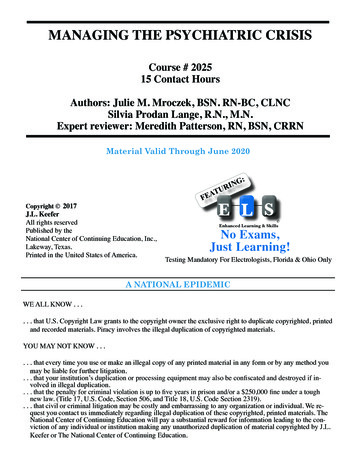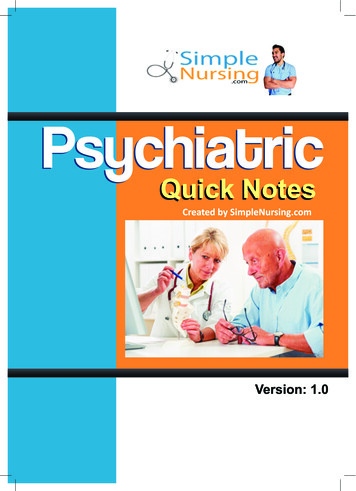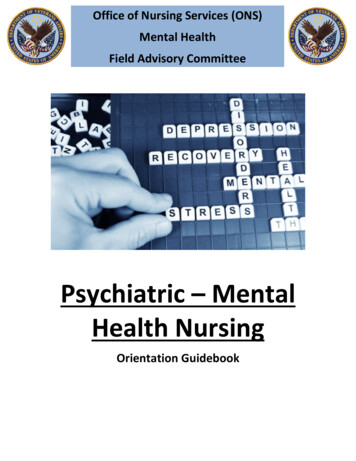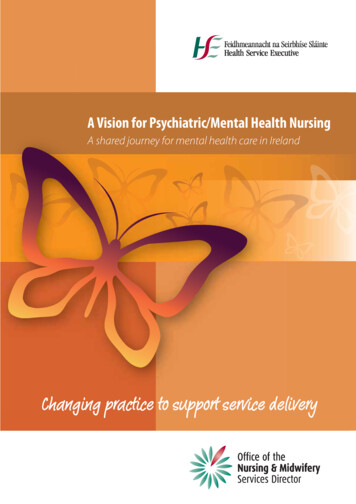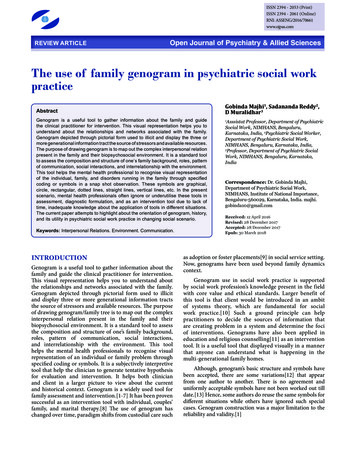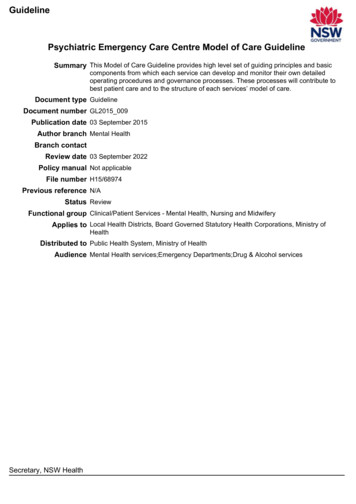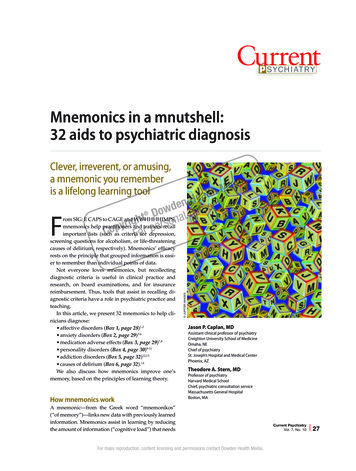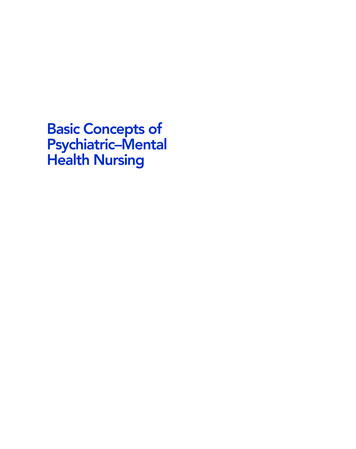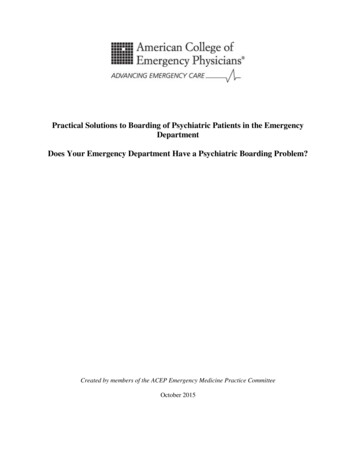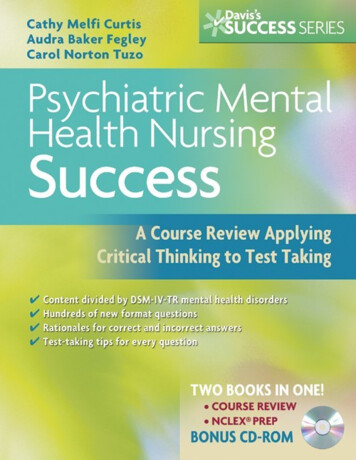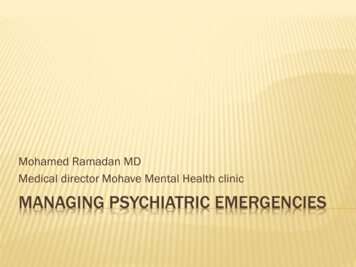
Transcription
Mohamed Ramadan MDMedical director Mohave Mental Health clinicMANAGING PSYCHIATRIC EMERGENCIES
Behavioral emergencies are common and thegoals of intervention are rapid evaluation,containment and referral to appropriate followup. Clinicians will likely be called upon to assessand manage agitation, acute psychosis andsuicidality; alone or in combination.
Identifying an accurate diagnosis is essential.Physicians need to be aware of the differencesamong the major psychiatric disorders, as wellas look for medical causes in patients withpsychiatric presentations.
Due to the complexity of a patients’ presentation,the emergency clinician must be a clinical andmedical specialist, anthropologist, detective anda diplomat.
In dealing with psychiatric patients, empathy is themost useful psychotherapy tool for understandingpatients’ feelings of grief, fear, agitation andpowerlessness. Patient's anger is often a defense againstintolerable emotions. Physicians are making decisions when a patients’impaired mental faculties prevent him/her frommaking sound autonomous decisions.
ACUTE PSYCHOSIS The definition of the term psychosis is“disorganized speech, grossly disorganized orcatatonic behavior, delusions or prominenthallucinations”.
Emergency physicians regularly attend topatients presenting with acute psychosis and20% of the patients are found to have a purelymedical etiology. Every disturbance of the central nervoussystem increases the probability thatpsychiatric symptoms will arise.
While the physician should be aware of thedifferences among the major psychiatricdisorders, it is equally important for physiciansto rule out medical causes in patients withpsychiatric presentations. Additionally, the source diversity of acutepsychosis mandates different approaches inmanagement.
CASE Two patients in their twenties reported to theemergency department with acute psychosis andsevere agitation.They had anxiety, restlessness, paranoia and visualhallucinations.In addition to dry mucous membranes, thirst, flushedface, blurred vision, hyperthermia, urinary retention,tachycardia and decreased intestinal motility.
CASEOne patient needed mechanical restrains forextreme agitation and the possibility of hurtinghimself Patients got IM antipsychotics (Haldol 5mg)and IM benzodiazepine (Ativan 2 mg) asneeded for psychosis, agitation and anxiety inaddition to IV fluids.
WHAT DO YOU DO NEXT?
One of the patients mothers called the ER andstated that they were drinking Moonflower teaand developed the manifestations ofanticholinergic syndrome. both patients obtained it from fields near wherethey live. user of such substance can eat it or drink teabrewed using the seeds
MANAGEMANTTreatment was mainly supportive care withintravenous fluids, gastrointestinaldecontamination and benzodiazepines asneeded for agitation. Phyostigmine can be used as an antidote insevere cases.
Differential diagnosis of non-psychiatric causesfor new onset acute psychosis is broad and itmay include a history of trauma, organ failure,neurological disorders, endocrine disturbances,metabolic imbalances, infection or a history ofingestion of toxins and/or illicit drugs.
After excluding medical causes of acute psychosis,the next step is to consider possible psychiatricdisorders. It is important to gather the patients’ pastpsychiatric history, substance abuse history andfamily psychiatric history Differential diagnosis of psychiatric disorders withpsychotic symptoms as a prominent aspect of apatients’ presentation includes psychoticdisorders, mood disorders and substance inducedpsychotic disorders.
MANAGEMENT Initial management should focus on attempts to calmthe patient through empathic, yet firm verbal means,and establishing a collaborative relationship betweenthe patient and the treatment team.When approaching an agitated psychotic patient, oneshould remember the potential for violence and theapproach should include speaking softly to the patientin non-judgmental way. It is better not to gaze directly inthe patients’ eyes, to appear calm, unthreatened, incontrol, and to be concerned about one’s own safety.
A violent patient should not be interviewed alone. Atleast one other person should be present. In situationsthat are more volatile, the other person should be asecurity guard or a police officer.Other precautions include leaving the interviewing roomdoor open and situating the interviewer between thepatient and the door.The emergency room physician must make it clear in afirm, non-angry manner to the patient that he/she maysay or feel anything, but are not free to act in violent orthreatening manner whatsoever.
The next step would be rapid tranquillization usingemergency medications that have the benefits ofreducing the agitated and psychotic state. Thesetypes of medications have been found to lessenthe time in seclusion and restraint and facilitategreater ease of the evaluative procedures. The choice of medications and the route ofadministration is guided by the degree of agitation,concomitant medical conditions, drug use andpatient preference.
Benzodiazepines and typical or atypical antipsychoticsare the main classes widely used. Occasionally, morethan one medication can be used and alternatingbetween different classes can be useful.Atypical antipsychotics are available in new formulationsfor treating behavioral emergencies (e.g. intramuscular[I.M.] olanzapine and ziprasidone; rapidly dissolvingtablets of olanzapine and risperidone). It isrecommended that calming, rather than sedation is themore appropriate endpoint of behavioral emergencyinterventions.
The last resort is to use physical restraints. Forexample, in centers providing Medicare andMedicaid services, the rules indicate the use ofrestraints when all other less restrictivemeasures have failed and unanticipatedseverely aggressive or destructive behaviorplaces the patient or others in imminentdanger.
THE AGITATED, THE IMPULSIVE AND THEAGGRESSIVEAgitation is a state of severe inner tension thatgenerally produces motor hyperactivity andbehavioral disorganization . Aggression is any behavior that is intended to bedestructive to persons, animals or objects. Impulsivity is the tendency to act without theability to match the act to its context to considerthe consequences for the self or others.Impulsivity includes greater motor activation, lessattention and less planning.
DIAGNOSIS Impulsivity and aggression are not limited to any specificpsychiatric disorder, or even to the presence of a ‘disorder’.Mechanisms that lead to agitation also predispose toimpulsivity, aggression and psychosis.These mechanisms include manic episode or mixed state ofbipolar affective disorder, intermittent explosive disorder,agitated depression, anger attacks in patients withdepression, posttraumatic stress disorder, obsessivecompulsive spectrum of disorders, anxiety disorders,dementia, delirium, psychotic disorders, personalitydisorders, especially cluster B (antisocial, borderline andnarcissistic), substance intoxication, including alcohol,stimulants and cannabis, or withdrawal from sedatives oralcohol.
.Medical disorders, such as metabolicimbalances, infections, trauma, neurologicaland endocrinal dysfunction could be causes ofimpulsivity, aggression and agitation.
Aggression is common in elderly patients withdementia and often leads to placement ofthese patients in long-term care facilities; it isbest understood as a product of the interactionof neurobiological, cognitive and environmentalfactors
MANAGEMENTOffer the patient help, food and bolster thepatient’s esteem by commenting on his or herstrengths and self-control efforts Do not touch or startle the patient, such asapproaching too quickly or closely withoutwarning. Finally, if the patient is transferred,inform the admitting physician about anyspecific threats and concerns.
THE SUICIDAL PATIENT Suicide is a serious, growing and complex public healthproblem, and its rate continues to rise. Each year30,000 Americans take their lives. It is estimated thateach year more than half a million Americans makesuicide attempts that are serious enough to warrantmedical attention.Suicide is by far the most common cause of prematuredeath among patients with major mood and psychoticdisorders. A major affective or psychotic disorderincreases the risk of suicide from 8 to 22 fold. A historyof at least one suicide attempt increases the patients’suicide risk 38 fold, so the likelihood of dying by suicidebecomes greater than one in four (28%).
Attempted suicide is approximately 10 to 20times more common than completed suicide inthe general population . Factors associated with increased risk forsuicidal behavior include a history ofpsychiatric disorders, previous suicide attemptsand recent losses
EVALUATION AND MANAGEMENT OF THESUICIDAL PATIENTThe most useful psychotherapeutic technique inthe treatment of a patient who is suicidal isestablishing a therapeutic alliance. It is thenimportant to determine patients’ personal anddemographic risk factors with diligent questionsregarding the patients’ social history, currentstressors or recent losses. Evaluation should include the assessment ofsuicidal ideas, wishes and motives, and then thesuicidal intent to act on such thoughts.
It is imperative to question the patient aboutspecific suicidal plans and then following up to seeif the details of the plan actually exist. It is of extreme importance to look for availablemeans for the patient, such as pills, guns, sharps,and even a vehicle if it is part of the suicide plan Assess the patient’s future plans, which shouldinclude questions to find out if the patient hasbeen giving up personal belongings, has written awill or recently put other affairs in order.
Evaluation of a suicide attempt is important inorder to understand the patient’s intention andmotivations. Asking about the method used,did the patient think it would work, was it adiscrete attempt, was the patient expecting tobe rescued, did the patient call anyone afterthe attempt, what was the reasoning behindthe attempt and was it an act of impulsivity orwas it well planed out?
In some cases, suicide can be combination ofdepression, hopelessness and impulsivity.After a complete evaluation, treatment andreferral depend on the patients’ risk for suicide.It is essential to incorporate family and friendsin the evaluation and eventually in thetreatment plan. It is crucial to mobilize thepatients’ social supports, as it is vital indetermining disposition.
Disposition of a patient with no risk to attemptsuicide should be with a quick follow upappointment that the patient can make and familyor responsible friends know about. Admission to the hospital is recommended topatients with suicidal risk or following suicidalattempt. Admission can be voluntary orinvoluntary according to the appropriate legalprocesses when necessary. Finally, carefully document the entire evaluation,decision-making process and dispositional steps.
THANK YOU
Emergency physicians regularly attend to patients presenting with acute psychosis and 20% of the patients are found to have a purely medical etiology. Every disturbance of the central nervous system increases the probability that psychiatric symptoms will arise.
